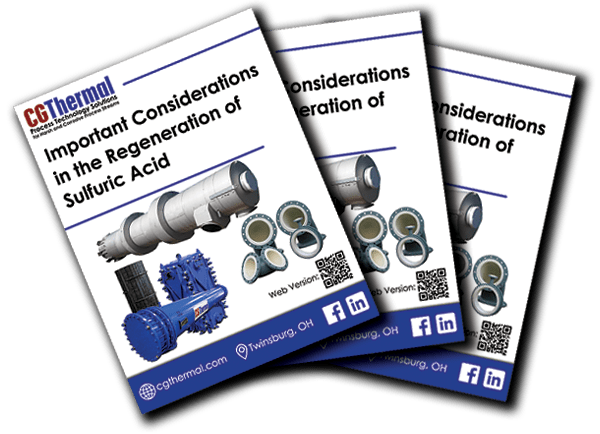Several sulfuric acid thermal properties require particular attention when considering heat and mass transfer systems and their design.
Viscosity
 The viscosity of sulfuric acid varies significantly with temperature and concentration. With increased concentration and a decrease in temperature, viscosity will rapidly increase. For example, viscosity of 5% H2SO4 at 200°F is 0.345cp while that of 93% H2SO4 at 80°F is 17.305cp.
The viscosity of sulfuric acid varies significantly with temperature and concentration. With increased concentration and a decrease in temperature, viscosity will rapidly increase. For example, viscosity of 5% H2SO4 at 200°F is 0.345cp while that of 93% H2SO4 at 80°F is 17.305cp.
This will then have a significant impact on pressure drop in the components throughout the system. This effect must be evaluated when designing a system to avoid inflated capital cost and unreasonable operating costs because high viscosity has a significant impact on liquid heat exchangers, pumps, and piping.
An increase in viscosity will result in a decrease in the heat transfer coefficient of the H2SO4 stream. For instance, a 14-fold increase in viscosity would result in a 4-fold decrease in the heat transfer coefficient of the acid.
Additionally, a lower tube velocity is required with a viscous fluid to keep the pressure drop within an acceptable range. Reduced velocity further reduces the Reynold’s number and in turn, the heat transfer coefficient. One solution to consider for reducing pressure drop with high viscosity acid may be to put the acid on the shell side of the heat exchanger using a corrosion resistant shell lining.
Because of these many considerations, a thorough evaluation of the heat exchanger design adds significantly to the value of the overall system design.
Vapor Pressure
Vacuum conditions are frequently required when re-concentrating sulfuric acid because it has a low vapor pressure.
At lower concentrations, the vapor pressure is mostly governed by the water. However, at higher concentrations, the degree of vacuum will have a more significant effect on the process temperature, which will in turn affect the energy input for the separation. This could result in higher process temperatures, reduced efficiency, and limited material options.
Electrical Conductivity
Electrical conductivity varies with concentration as a parabolic function, resulting in two concentrations described by the same value. This condition needs to be considered in choosing measurement and control devices.
Several approaches can be taken depending on the precision required. A Coriolis meter is commonly used to measure both mass flow and density. This will provide precise measurement and control when low deviations in concentration are required.
Conclusion
Outside of design, there are still many other considerations to take when working with heat transfer applications of sulfuric acid, including the materials of construction for heat transfer, transport, and storage.
Want to learn more? Download CG Thermal’s White paper below on the important considerations in the regeneration of sulfuric acid, or contact us today for more information.



